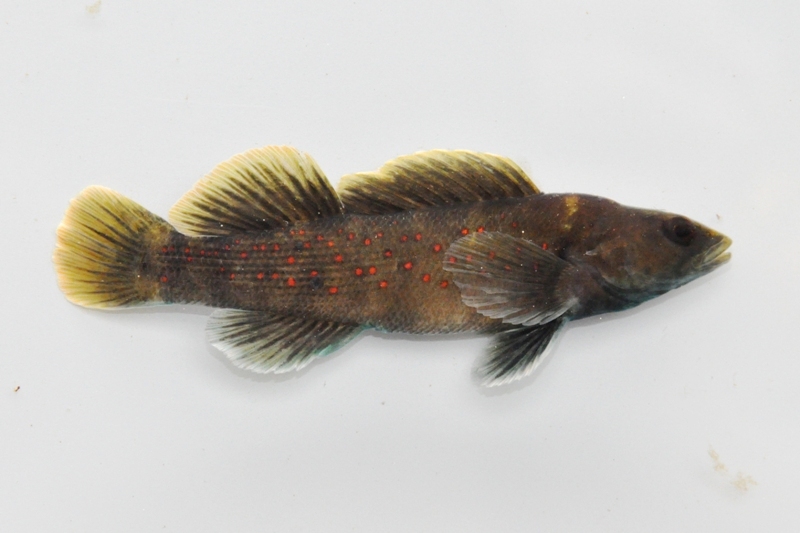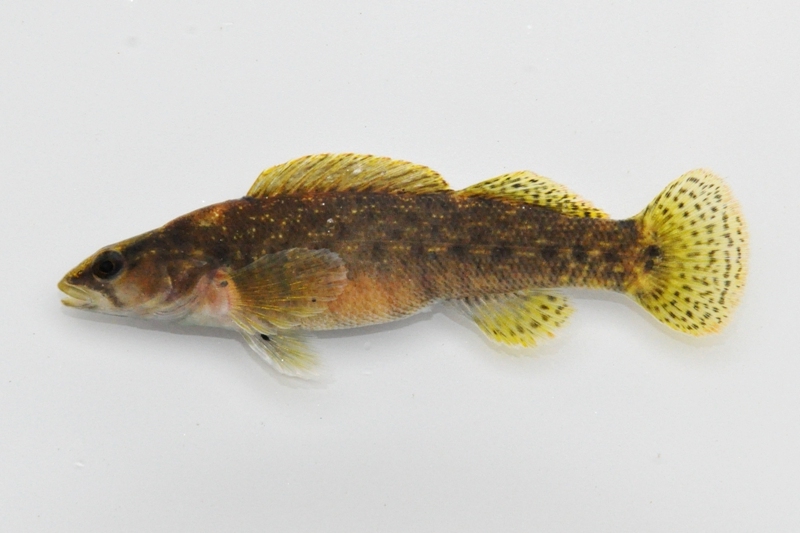Spotted Darter
(Etheostoma maculatum)


The spotted darter is an indicator of very high quality streams in Ohio and are only found in few streams in the state. Male (left) and female (below) spotted darters display very different color patterns.
Description
The spotted darter has a sharply pointed snout and a rounded tail. They often have a very dark brown over all body coloration with a series of 7-10 dark colored saddles over their back. The narrow spaces between these saddles are much lighter colored than the rest of the fish. They have many narrow dark stripes running horizontally along their sides which are most visible near the tail. The outer edge of all of their fins is lighter colored with no dark margins. The closely related bluebreast darter has distinct dark outer margins on all fins, a larger eye, and a blunt rounded snout. Male spotted darters have many small round bright red spots on the sides of their body that are uniform in size and shape. Both dorsal fins and the tail are a dark dusky color at the base and fade to a light yellow on the outer edges. The pectoral, pelvic, and anal fins also are a dark dusky color at their base. These fins then fade into a green color and then have white outer edges. Female spotted darters are very differently colored than males. They have dark spots on their side that are less numerous, usually larger than the red spots on a male, and not as uniform in size or shape. All of their fins are a light yellow or brown color with dark spots on both dorsal, tail, and anal fins. Female spotted darters also often have faint dusky vertical bands on the back half of their sides and a tear drop under the eye.
Habitat and Habits
Spotted darters are found in medium sized rivers and streams. They are typically found in areas of swift current at the top or bottom end of a riffle where there are many very large boulders or flat slabs of rock. They spend most of their time hiding under the upstream edge of these large rocks with their head sticking out watching for food. In Ohio the spotted darter was historically found in parts of the Mahoning, Muskingum, and Scioto River drainages. Today they are still found in very limited portions of Big Darby Creek, Paint Creek, and Little Walnut Creek of the Scioto River drainage. They are also found in limited areas of the Kokosing and Walhonding Rivers of the Muskingum River drainage. No spotted darters have been found in the Mahoning River drainage since the 1850's. This species is an indicator of very high quality streams.
Reproduction and Care of the Young
Spotted darters spawn in June and July. Males guard territories underneath the upstream edge of large rocks. Females lay their adhesive eggs on the underside of these rocks. Males will often mate with and guard the eggs of multiple females until the eggs hatch. After the eggs hatch no further parental care is given.